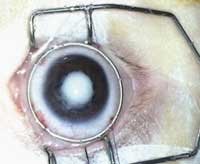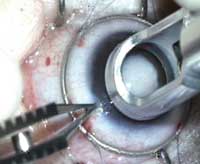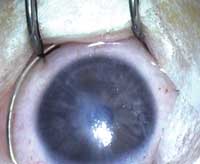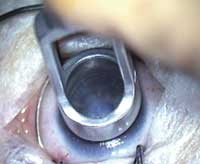Pediatric PKP results improving over time, surgeon says
Acknowledging that children’s ocular tissue behaves differently from that of adults is crucial to surgical success.
PARIS – Successful corneal grafting can be achieved in infants provided that surgeons follow the specific requirements connected with the anatomy and physiology of these young eyes, according to Pascal Dureau, MD, PhD.
“We must first of all be aware that keratoplasty in these young patients is a difficult surgery, with a high risk rate and a reserved prognosis. Indications, surgical procedure and follow up are very specific, and amblyopia is a major obstacle to success,” he said at the meeting of the French Society of Ophthalmology (SFO).
Specific indications may be connected with a variety of congenital and malformation syndromes, infectious diseases or ocular trauma, which often leads to particularly severe sequelae in infant eyes. Corneal dystrophies are less represented, as they derive from corneal infiltration of metabolic disorders or from keratoconus, which is more rare in infants.
Crucial to the success of surgery is the acknowledgment that children’s ocular tissue behaves differently from that of adults.
“Infants have smaller eyes, a less rigid sclera and a stronger vitreous push. These characteristics require special instruments and specific surgical maneuvers,” Dr. Dureau said.
Surgical technique
To reduce the vitreous push and prevent dislocation of the iris, a Flieringa ring is fixed to the episclera with four nylon sutures, and suspended with the lid speculum.
“This first crucial maneuver is lifting the globe and minimizing the vitreous push. Those who are accustomed to performing penetrating keratoplasty in children have surely had the experience of the iris coming out after trephination. It is a relatively common event, but the use of Flieringa ring helps in most cases,” Dr. Dureau said.
A manual disposable trephine is used to fashion the host button. The Hanna trephine is unsuitable for small eyes, because its diameter is not small enough.
“The donor button is oversized by half a millimeter in all cases, to increase the anterior chamber depth and to progressively adapt to the growing globe,” he added.
Interrupted sutures are applied to allow for early and, in some cases, partial and quick removal. Additional maneuvers like synechiolysis or pupilloplasty are often also required.
Postoperative treatment requires instillation of local cortical steroids for one year and, since 2004, the use of 2% cyclosporine drops four times daily.
“The use of cyclosporine seems to minimize the risk of rejection and improve the prognosis of this surgery,” Dr. Dureau said.
In very young children, sutures must be removed quite soon after the operation, he said. Usually half of the sutures are removed within a month, and the other half within 2 months at the latest, under general anesthesia.
  |   |
| To reduce the vitreous push and prevent dislocation of the iris, a Flieringa ring is fixed to the episclera with four nylon sutures, and suspended with the blepharostat. Images: Dureau P | |
Results
The results of penetrating keratoplasty in 18 eyes of 19 children operated on over a period of 4 years at the Rothschild Foundation in Paris were evaluated in a retrospective study. The mean age of children was 17 months. There were six cases of congenital corneal opacification due to Peter’s anomaly, three due to congenital glaucoma, and two to sclerocornea, five traumatic corneal scars, two cases of corneal scars following infectious keratitis and one dermoid cyst located at the center of the cornea.
“As expected, the difficult indications with severe associated lesions resulted in a high rate of rejection, especially in post-traumatic eyes, where we had five cases. Three cases occurred in the children with Peter’s anomaly, and one in one case of sclerocornea. We also had three cases of retinal detachment, two of which were in post-traumatic eyes, and four secondary cataracts, probably due to the therapy with topical steroids, which must be aggressive to minimize the risk of rejection,” Dr. Dureau said.
However, final results were quite encouraging. A clear graft was obtained in 13 eyes, during a mean follow up of 2.5 months (range 6 to 45 months).
“It’s not yet a long time, of course, if we consider the hopefully long life expectation of these children,” he pointed out.
The mean postoperative refraction was –1.4 D, with a wide range between –12 D and +10 D.
“The predictability in these cases is always very low, no matter how much care we use during surgery. However, we can be satisfied with the results we have obtained,” he said.
Functional results were of course difficult to evaluate due to the very young age of the children. “Discriminating unilateral and bilateral visual acuity is of course impossible, but on the whole functional results are always in the low range of vision. In our series of cases very few children had a good visual acuity, and the best results were obtained in one child who was operated for ocular trauma at a relatively older age,” Dr. Dureau said.
Better results, open questions
Although still relatively poor, these results are much better than those that could be expected 20 to 30 years ago, and thanks to the improvement in surgical technique and postoperative treatment corneal transplantation can now be offered to more and increasingly younger children.
High-frequency ultrasound is now a well-established tool of the examination of the anterior segment, and has been a big step forward in defining the indications and selecting the patients for this surgery, particularly in eyes with corneal opacity. Whether this surgery should only be bilateral or also monolateral is still a matter for discussion.
“Some specialists believe that a strictly monolateral pathology is better not to be operated on. This topic can be discussed endlessly, because functional results are so difficult to assess,” Dr. Dureau said.
Amblyopia, he said, remains an unsolved problem with pediatric corneal transplantation, and plays a major role in the functional results of this surgery. To minimize the problem, surgery should be performed as early as possible and an aggressive visual rehabilitation program should be followed.
“Long-term results and the role of alternative surgical techniques, like deep anterior lamellar keratoplasty (DALK) will be assessed in future years,” he concluded.
For more information:
- Pascal Dureau, MD, PhD, can be reached at Fondation Rothschild, 25 Rue Manin, 75019 Paris, France; +33-1-48-03-66-49; fax: +33-1-48-03-6537; e-mail: pdureau@fo-rothschild.fr. Dr. Dureau has no financial interest in any products mentioned in this article.
- Michela Cimberle is an OSN Correspondent based in Treviso, Italy, who covers all aspects of ophthalmology. She focuses geographically on Europe.
